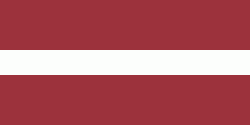Mērsrags
Mērsrags (Markgrafen) is a small harbor town in Talsi Municipality in the Courland region of Latvia, located on the west coast of the Gulf of Riga, beside Lake Engure and surrounded by extensive woodlands. The total area of the former Mērsrags municipality was 109 km2 (10896.2 ha). 63.7% of this area was woodland and Lake Engure covered 20.4%. The coastline was about 12 km. long. The town center is some 42 km from Talsi, the main city of the area, and some 95 km. from the capital, Riga.
Mērsrags had a population of 1986 in June 2008.
Many types of landscape can be seen; seaside, lake reservation, everglades, lagoons, the bed of the dried-up Litorīnas lake (Litorīnas ezers), the sand dune forest, and rural and urban landscapes.
The earliest information about Mērsrags is from the 15th century, when it was a small fishing hamlet beside the Gulf of Riga. There are many stories and myths about Mērsrags. Pirates, who lured ships ashore and plundered them, used to live here. During the ducal period, there was a large production of soap.
In 1842 a canal was dug from the north end of Lake Engure to the sea and in 1843 Mērsrags began to develop. In 1880 a lighthouse had been completed and the first ship was launched from the dockyard. Altogether 22 sailing ships were built in Mērsrags. Between 1860 and 1915, 66 sailing ships were built in Upesgrīva village.
Until 1918, Mērsrags village and Upesgrīva village belonged to the parish of the Engure manor but, in 1918, Mērsrags became a separate parish. Likewise in 1926 Upesgrīva became a separate parish.
In 1926 a narrow-gauge railway came to Mērsrags and in 1927 the port was built to satisfy the needs of fishing boats and shipping.
In the 1960s the development of the fish farm collective resulted in a great increase in the production of fish and canned products. The first block of flats and a distant steam heating plant were built. A new fish processing plant was constructed as well as a net repair shop and an engineering workshop. The village roads were repaired and asphalted. Fishing remains an important aspect of the economy, with smoked fish being one of the local specialties.
Mērsrags had a population of 1986 in June 2008.
Many types of landscape can be seen; seaside, lake reservation, everglades, lagoons, the bed of the dried-up Litorīnas lake (Litorīnas ezers), the sand dune forest, and rural and urban landscapes.
The earliest information about Mērsrags is from the 15th century, when it was a small fishing hamlet beside the Gulf of Riga. There are many stories and myths about Mērsrags. Pirates, who lured ships ashore and plundered them, used to live here. During the ducal period, there was a large production of soap.
In 1842 a canal was dug from the north end of Lake Engure to the sea and in 1843 Mērsrags began to develop. In 1880 a lighthouse had been completed and the first ship was launched from the dockyard. Altogether 22 sailing ships were built in Mērsrags. Between 1860 and 1915, 66 sailing ships were built in Upesgrīva village.
Until 1918, Mērsrags village and Upesgrīva village belonged to the parish of the Engure manor but, in 1918, Mērsrags became a separate parish. Likewise in 1926 Upesgrīva became a separate parish.
In 1926 a narrow-gauge railway came to Mērsrags and in 1927 the port was built to satisfy the needs of fishing boats and shipping.
In the 1960s the development of the fish farm collective resulted in a great increase in the production of fish and canned products. The first block of flats and a distant steam heating plant were built. A new fish processing plant was constructed as well as a net repair shop and an engineering workshop. The village roads were repaired and asphalted. Fishing remains an important aspect of the economy, with smoked fish being one of the local specialties.
Map - Mērsrags
Map
Country - Latvia
 |
 |
| Flag of Latvia | |
After centuries of Teutonic, Swedish, Polish-Lithuanian and Russian rule, which was mainly executed by the local Baltic German aristocracy, the independent Republic of Latvia was established on 18 November 1918 when it broke away from the German Empire and declared independence in the aftermath of World War I. However, by the 1930s the country became increasingly autocratic after the coup in 1934 establishing an authoritarian regime under Kārlis Ulmanis. The country's de facto independence was interrupted at the outset of World War II, beginning with Latvia's forcible incorporation into the Soviet Union, followed by the invasion and occupation by Nazi Germany in 1941, and the re-occupation by the Soviets in 1944 to form the Latvian SSR for the next 45 years. As a result of extensive immigration during the Soviet occupation, ethnic Russians became the most prominent minority in the country, now constituting nearly a quarter of the population. The peaceful Singing Revolution started in 1987, and ended with the restoration of de facto independence on 21 August 1991. Since then, Latvia has been a democratic unitary parliamentary republic.
Currency / Language
| ISO | Currency | Symbol | Significant figures |
|---|---|---|---|
| EUR | Euro | € | 2 |
| ISO | Language |
|---|---|
| LV | Latvian language |
| LT | Lithuanian language |
| RU | Russian language |















